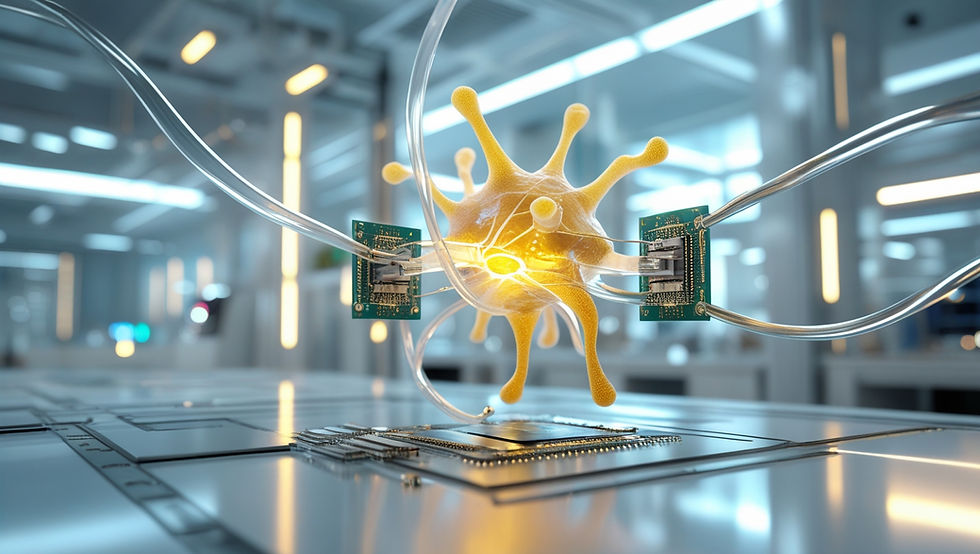How Biocomputing Can Transform the World Around Us.
- Mayda Asif

- Sep 10
- 4 min read

Biocomputing is an enormous effort of compacting computational power and increasing its efficiency to push past our current technological limits.
Says Dr. Thomas Hartung, professor of environmental health and engineering at the Johns Hopkins Bloomberg School of Public Health and Whiting School of Engineering in Baltimore
What is Biocomputing?
It is defined as the use of biological material, such as DNA, proteins, living cells, or neural networks, to perform complex computational tasks, store large amounts of data, carry out logical operations, and transform raw data into useful information.
Major Domain of Biocomputing
Following are a few of the important fields of biocomputing.
DNA Computing delicately utilizes high-precision mechanisms of DNA to encode, store, and manipulate data to find specific answers for a particular query.
Enzymes and proteins act as effective catalysts in a biological environment, i.e., they react only when the situation is suitable. A catalyst can make or break a chemical reaction, similar to ON/OFF logical gates. Referring to this property of proteins and enzymes, they are used as logical gates to perform highly accurate tasks and to create biomemory.
Whole cells can act as a computing unit by selectively programming the cell's synthetic DNA. A cell with synthetic genetic material can perform all the functions that the DNA is programmed to do.
Neuron-on-a-chip is the most advanced form of biocomputing and is characterized by growing living organoids from a human or animal stem cell source. These organoids can replicate certain structural and functional capabilities of their prototype (stem cells).
Applications of Biocomputing
Human brain organoids:
One of the most innovative creations of neuron-on-a-chip is neuroplatform. Developed by Swiss scientists, Neuroplatform consists of lab-grown mini-brains or organoids that can mimic the structure and function of the frontal part of human brain. The neural activities within this organoid can be monitored, analyzed, and manipulated by the integration of a specialized microchip called strip MEA. With the use of neuroplatform, researchers can solve complex problems, save a large amount of data, and retrieve useful information, all while consuming electricity equal to that of a light bulb.
Drug delivery through nano-robots:
Nano-robots integrated with enzyme-protein-based logical gates can be injected into the bloodstream where they move freely until they sense abnormal cells through their biomarkers, like surface proteins. After successfully detecting the abnormal cells and meeting all the conditions of logical gates, these robots open up and release the drugload. This plays a significant role in targeted therapy of diseases like cancer.
Drug-testing:
Lab-grown organoids derived from stem cells can be used as biosensors for drug testing. This eliminates the need for in-vitro or animal-based studies and also fulfills the research criteria of human organ-based drug testing results.
Neuromorphic learning:
In contrast to traditional AI technology, brain-driven processors can self-learn based on their previous experiences and external stimuli. This neuromorphic technology is actively used in brain-computer interface of smart prosthetics.
Current limitations
Even the most advanced forms of biocomputers cannot live after a few months
The neuromorphological characteristics are unique for each organoid. This memory can not be saved or transferred to the next batch.
Living cells are highly unpredictable and behave differently to similar stimuli at different times, making it hard to reproduce results of a similar question
All forms of biocomputers are hard to scale. They require a large sum of resources combined with unparalleled precision.
It requires a lot of effort to transform neurological signals into digital data with high accuracy.
Biological cells produce weak signals that are highly receptive to their environment, making it nearly impossible to turn neural waves into meaningful information.
Using organoids that can potentially replicate the human brain raises serious ethical questions on how we perceive life, science, and living tissues.
Sources
Tugui, A., Danciulescu, D., & Subtirelu, M.-S. (2019). The Biological as a Double Limit for Artificial Intelligence: Review and Futuristic Debate. International Journal of Computers Communications & Control, 14(2), 253–271. https://doi.org/10.15837/ijccc.2019.2.3536
Yoon, J., Lim, J., Shin, M., Lee, J.-Y., & Choi, J.-W. (2022). Recent progress in nanomaterial-based bioelectronic devices for biocomputing system. Biosensors and Bioelectronics, 212, 114427. https://doi.org/10.1016/j.bios.2022.114427
Goñi-Moreno, A., & Nikel, P. I. (2019). High-Performance Biocomputing in Synthetic Biology–Integrated Transcriptional and Metabolic Circuits. Frontiers in Bioengineering and Biotechnology, 7. https://doi.org/10.3389/fbioe.2019.00040
Jordan, F. D., Kutter, M., Comby, J.-M., Brozzi, F., & Kurtys, E. (2024). Open and remotely accessible Neuroplatform for research in wetware computing. Frontiers in Artificial Intelligence, 7. https://doi.org/10.3389/frai.2024.1376042
Alam El Din, D.-M., Shin, J., Lysinger, A., Roos, M. J., Johnson, E. C., Shafer, T. J., Hartung, T., & Smirnova, L. (2024). Organoid intelligence for developmental neurotoxicity testing. Frontiers in Cellular Neuroscience, 18. https://doi.org/10.3389/fncel.2024.1480845
Stoppini, L., Heuschkel, M. O., Loussert-Fonta, C., Gomez Baisac, L., & Roux, A. (2024). Versatile micro-electrode array to monitor human iPSC derived 3D neural tissues at air-liquid interface. Frontiers in Cellular Neuroscience, 18. https://doi.org/10.3389/fncel.2024.1389580
Xu, M., Qin, Z., Chen, Z., Wang, S., Peng, L., Li, X., & Yuan, Z. (2024). Nanorobots mediated drug delivery for brain cancer active targeting and controllable therapeutics. Discover Nano, 19(1), 183. https://doi.org/10.1186/s11671-024-04131-4
Smirnova, L., Caffo, B. S., Gracias, D. H., Huang, Q., Morales Pantoja, I. E., Tang, B., Zack, D. J., Berlinicke, C. A., Boyd, J. L., Harris, T. D., Johnson, E. C., Kagan, B. J., Kahn, J., Muotri, A. R., Paulhamus, B. L., Schwamborn, J. C., Plotkin, J., Szalay, A. S., Vogelstein, J. T., … Hartung, T. (2023). Organoid intelligence (OI): the new frontier in biocomputing and intelligence-in-a-dish. Frontiers in Science, 1. https://doi.org/10.3389/fsci.2023.1017235
Strickland, A. (March 2, 2023).Move over, artificial intelligence. Scientists announce a new ‘organoid intelligence’ field. CNN World https://edition.cnn.com/2023/03/02/world/brain-computer-organoids-scn/index.html
Thomas Hartung and colleagues | The Future of Organoid Intelligence | Deep Dive 2023 https://www.youtube.com/watch?v=3dIjWDCchtc
Assessed and Endorsed by the MedReport Medical Review Board






